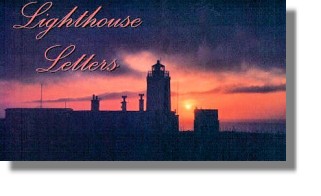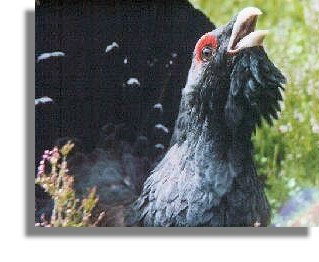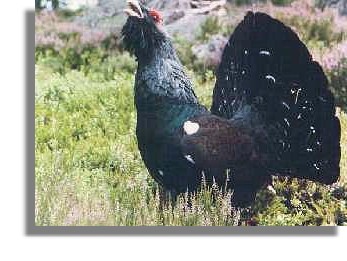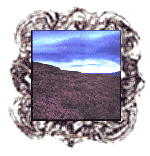

Lighthouse Letters
By Sharma Krauskopf
This is an article by Sharma Krauskopf from Michigan who fell in love with Scotland - and decided to buy a lighthouse keepers' cottage at Eshaness, a remote location in Shetland, in the far north of Scotland and live there each winter. These pages were previously part of the "Scottish Radiance e-magazine Web site which was created by Sharma.
Capercaillie - The Cock of the Wood
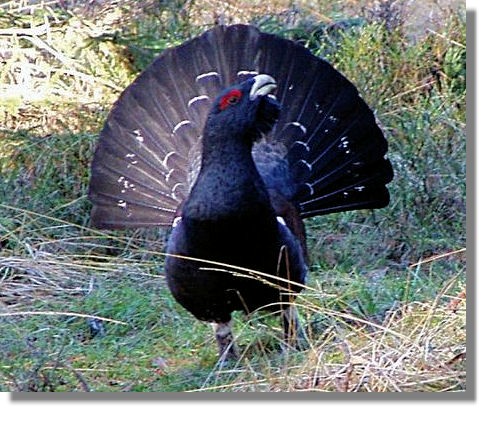
Photo of Capercaillie via Wikimedia
Click clock! Click clock, Click clock. The capercaillie cock is calling for a mate. It is spring in the wildwood of Caledon. My last trip to Scotland I met Jim McBain who is the gardener at the Tobmore Distillery but who's hobby is hillwalking and photography. The cock in Jim's pictures he calls a "rogue". Jim came upon him in the woods and he was very curious about these humans. In fact Jim got so close he has a scar on his finger where the cock decided to taste him. He gave me many wonderful pictures of "cappies" - such as the one on the right. Being Spring I felt compelled to use his pictures and do a story on what the Gaels call the "Capullcoille", the cock of the wood or Capercaillie. Most of us are familiar with the singing group which has taken this beautiful bird as their name but I did not know until recently capercaillie was first and foremost a Scottish bird.
The capercaillie is a rare bird in Scotland. The population plummeted from a high of 10,000 pairs in the 1960s to less than 1000 birds in 1999. All are descendants from birds reintroduced from Sweden in the 19th century after the Scottish capercaillie had become extinct, probably due to the extensive felling of pinewoods. These incomers rapidly spread aided by further introductions as recently as 20 years ago. Capercaillies were found in suitable woodlands from the Cowal peninsula in the west right across to Buchan in the north-east of Scotland. But since then things have gone wrong, and now the only strongholds are in Deeside, Starthspey and parts of Perthshire, with a few isolated outposts elsewhere. Being so shy it is the exception rather than the rule to get a decent view of one. They are very difficult to see in the woods even though they are very large. Most of the time they see you before you see them and fly off. (Perhaps the best chance of "seeing" Capercaillies is the sculpture collection at Dalerb in the Tay Forest Park - see graphic on the left).
The disappearance of the bird is blamed on many things including the increased fox population which get the babies and the eggs to the disturbance of man in their habitat since they are basically very shy birds. Wetter weather may be taking the young chick since they are susceptible to chilling.
The Scottish capercaillie is indeed impressive. The male is a large dark turkey-like bird, weighing over four kilos. He has a long broad tail and distinctive beak.
The female is much smaller and less than half the weight. She is brownish with dark flecks, ideally camouflaged for incubating eggs and looking after the young. Across her chest is a lighter band of chestnut. At first glance it is hard to believe the cock and hen birds belong to the same species, such is the difference in size and appearance. In early May the hen lays five to eight eggs in a shallow scrape in the forest floor. The eggs are attractive: pale yellowish buff, with fine speckling sparse brown blotches. Only the female incubates. By early June the eggs have hatched and the downy chicks leave the nest shortly afterwards. If feeding is good, growth is rapid, and after a few weeks the youngsters' wings are feathered.
The current status of the capercaillie in Scotland is precarious to say the least. But the omens are good. It is a vulnerable bird and in some cold and wet summers chick mortality is high. But over time this will balance out with surpluses produced in other years.
There is David Attenborough YouTube Video showing a Capercaillie defending its territory against another bird - and against an intrusion by David Attenborough himself!
Return to Index of Lighthouse Letters or Index of All Guest Writers
